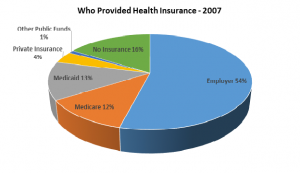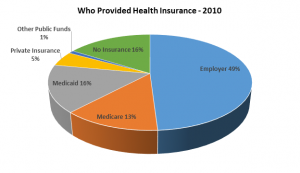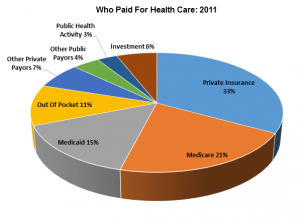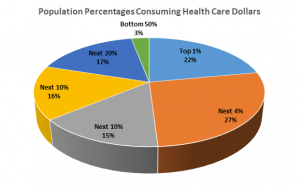Any substantive discussion of health care requires a solid foundation. So here’s a primer on health care expenditures – where the money came from and where it went – prior to the ACA.
Who provides our insurance: in 2007, a little more than half of us (54%) had employer-provided health insurance. Medicare, Medicaid and SCHIP covered another 26%, and 4% of people purchased their own insurance. Sixteen percent of us had no insurance.
Source: Kaiser Family Foundation State Health Facts – 2007
But three years later, things had changed significantly. Less than half of us got insurance from our employers. Medicaid and Medicare coverage rose to 16% and 13%; private insurance covered 5%. The percentage of uninsured remained the same.
Source: Kaiser Family Foundation – State Health Facts
Government employees get their insurance with taxpayer dollars, not employer revenue. The American Federation of State, County and Municipal Employees (AFSCME) has 1.6 million members. The American Federation of Government Employees (AFGE) and the National Federation of Federal Employees (NFFE) together have 700,000 members. There are 1.8 million active duty service men and women, many with dependent families, receiving “government-run health care.” Add veterans and their families covered by TRICARE and the Civilian Health and Medical Program of the Department of Veterans Affairs (CHAMPVA) and we are much closer to “socialized medicine” than any politician will ever admit.
Who pays for health care: Government is already the single largest health care purchaser; In Medicare, Medicaid, the State Children’s Health Insurance Program (SCHIP) and other public funds paid 40% of health care costs in 2011. And just to clear up any misconceptions, two thirds of Medicaid funds go for care of the elderly and disabled. Yep, Medicaid pays for your grandmother’s nursing home, not Medicare, which only covers skilled nursing care.
Private insurance paid for 33% of expenditures; out-of-pocket spending and other private funds accounted for 11% and 7%, respectively.
Source: California Health Care Foundation
Where our health care dollars go: Hospitals receive 31.4% of our health care dollars; doctors get 19.9% and drugs consume another 10.1%. Nursing homes receive 5.5% and we spend 2.7% on home health care. “Other Personal Health Care Spending” includes goods and services such as dental, vision and durable medical equipment. “Other Health Spending” includes administrative costs, research, public health services, buildings and equipment.
Sources: Kaiser Family Foundation and Centers for Medicare & Medicaid Services
Who do we spend it on? The good news is half of us rarely need medical care, accounting for about 3 percent of all health care spending. The bad news is 5 percent of us are responsible for almost half of expenditures. The top 1% of people are “super-utilizers,” whose chronic, poorly managed illnesses account for 22% of our annual bill.
Source: Agency for Healthcare Research and Quality
One would expect caring for the elderly to be more expensive, but the United States spends far more than other countries.
I’ll try to explain WHY we spend so much money in my next post.








